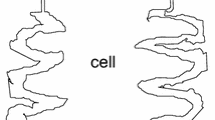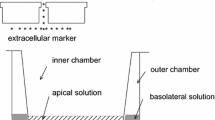Abstract
The purpose of the present work is to investigate whether the idea of epithelial fluid transport based on electro-osmotic coupling at the level of the leaky tight junction (TJ) can be further supported by a plausible theoretical model. We develop a model for fluid transport across epithelial layers based on electro-osmotic coupling at leaky tight junctions (TJ) possessing protruding macromolecules and fixed electrical charges. The model embodies systems of electro-hydrodynamic equations for the intercellular pathway, namely the Brinkman and the Poisson-Boltzmann differential equations applied to the TJ. We obtain analytical solutions for a system of these two equations, and are able to derive expressions for the fluid velocity profile and the electrostatic potential. We illustrate the model by employing geometrical parameters and experimental data from the corneal endothelium, for which we have previously reported evidence for a central role for electro-osmosis in translayer fluid transport. Our results suggest that electro-osmotic coupling at the TJ can account for fluid transport by the corneal endothelium. We conclude that electro-osmotic coupling at the tight junctions could represent one of the basic mechanisms driving fluid transport across some leaky epithelia, a process that remains unexplained.





Similar content being viewed by others
References
Barfort P., Maurice D.M. 1974 Electrical potential and fluid transport across the corneal endothelluin. Exp. Eye Res. 19:11–19
Bastug T., Kuyucak S. 2003. Role of the dielectric constants of membrane proteins and channel water in ion permeation. Biophys. J. 84:2871–2882
Brink H.C. 1947, A calculation of the viscous force exerted by a flowing fluid on a dense swarm of particles. Appl. Scient. Res. A1:27–35
Broday D.M. 2002. Motion of nanobeads proximate to plasma membranes during single partiote tracking. Bull. Math. Biol. 64:531–63
Claude P. 1978. Morphological factors influencing transepithelial permeability: a model for the resistance of the zonula occludens. J Membrane Biol 39:219–32
Claude P., Goodenough D.A. 1973. Fracture faces of zonulae occludentes from “tight” and “leaky” epithelia. J Cell Biol 58:390–400
Colegio O.R., Van Itallie C., Rahner C., Anderson J.M. 2003. Claudin extracellular domains determine paracellular charge selectivity and resistance but not tight junction fibril architecture. Am. J. Physiol. 284:C1346–C1354
Colegio O.R., Van Itallie C.M., McCrea H J., Rahner C., Anderson J.M. 2002. Claudins create charge-selective channels in the paracellular pathway between epithelial cells. Am. J. Physiol. 283:C142–C147
Donath E., Pastushenko .V 1979. Electrophoretical study of cell surface properties. Bioelectrochem. Bioenerg 6:543–554
Donath E., Pastushenko V., Chizmadjev Y. 1978. Electroosmottc flow in the hydrodynamic closed, chamber. Studies in Biophysics 68:145–154
Donath E., Voigt A. 1986a. Electrophoretic mobility of human erythrocytes. On the applicability of the charged layer model. Biophys 49:493–499
Donath E., Voigt A.. 1986b. Streaming current and streaming potential on structured surfaces. J. Colloid Interface Sci 109:123–139
Fischbarg J. 1972. Potentml diffetence and fluid transport acmss rabbit corneal endothelium. Biochim. Biophys. Acta 228:362–366
Fischbarg, J., Rubashkin, A., Iserovich, P. 2004. Electro-osmotic coupling in leaky tight junctions is thoretically possible. In: Experimental Biology 2004, pp. A710 (Abstract #463.6) FASEB, Washington, D.C.
Fischbarg L, Warshavsky C.R., Lim J.J. 1977. Pathways for “hydmulically and osmotically-induced water flows across epithelia. Nature 266:71–74
Gross R.J., Ostcrle J.F. 1968. Membrane transport characteristics of ultrafine capillaries. J. Chem. Phys. 49:228–234
Guo P., Weinstein A.M., Weinbaum S. 2000, A hyctrodynamic mechanosetisory hypotheses for brush border microvilly. Am. J. Physiol. 279:F69B–F712
Guo P., Weinstein. A.M., Weinbaum S. 2003. A dual-pathway ultrastructural model for the tight junction of rat proximal tubule epithelium. Am J. Physiol. 285:F241–F257
Hanter R.J., 1981. Zeta Potential in Colloid Science; Principles arid Applications, Academic Press, New York
Happel, J., Brenner, H. 1983. Low Reynolds Number Hydrodynamics: with Special Applications to Particulate Media. M. Nijhoff; Distributed by Kluwer Boston, The Hague
Harned, H.S., Owen, B.B. 1958, The Physical Chemistry of Electrolytic Soltions. Reinhold, New York
Hill A.E., Shachar-Hill B., Shaohar-Hill Y. 2004. What are aquaporins for? J. Membrane Biol 197:1–32
Hodson S. 1974. The regulation of corneal hydration by a salt pump requiring the presence of sodium and bicarbonate ions. J. Physiol. 236:271–302
Jones I.S. 1979. A theory of electrophoresis of large colloid particles with adsorbed polyelectrolyte. J. Colloid Interface Sci 68:451–461
Kaye G.I., Sibley R.C. Hoefle F.B. 1973. Recent studies on the nature and function of the corneal endothelial barrier. Exp. Eye Res. 15:585–613
Keh H.J., Liu Y.C. 1995. Elecctrokinetic flow in a circular capillary with a Hurfiice charge layer. J. Colloid Interface Sci. 172:222–229
Kruyt H.R. 1952. Colloid Science, Elsevier, New York
Kuang K., Ma, L., Sanchez J.M., Fischbarg, J. 2004. Claudin expression and paracellular permeability in cultured rabbit corneal endothelial cells (rce). Invest. Ophthalmol. Vis. Sci. 45:E-Abstract 1090
Lakshminarayanaiah N. 1984. t:quatiom of Membrane Biophysics. Academic Press. Orlando
Larsen. E.H., Sorensen J.B., Sorensed J.N. 2002. Analysis of the sodium recirculation of theory of solute-coupled water transport in small intesltae. J. Physiol 542:33–50
Levine S., Levine M., Sharp K.A., Brooks D.E. 1983. Theory of the electrokinetic behavior of human erythrocytes. Biophys 42:127–135
Loo D.D., Wright E.M., Zeuthen T. 2002. Water pumps. J. Physiol. 542:53–60
McLaughlin S., Muthias R.T. 1985 Electro-osmosis and the reabsorption of fluid in renal proximal tubules. J. Gen. Physiol. 85:699–728
Naftalin RJ, Tripathi S. 1985. Passive water flows driven across the isolated, rabbit ileum by osmotic, hydrostatic and electrical gradients. 360:27–50
Pasquale L.R., Methlas R.T., Austin. L.R., Brink P.R., Ciunga M. 1990, Electrostrostatic properties of fiber cell membranes from the frog lens. Biophys. J. 58:939–945
Reuss L. 2000. General of water transport. In: D.W. Seldin, G. Giebisch. (editors), The Kidney, Physiology and Pathophysiology (chapter 13). Raven Press, New York pp 321–340
Reuss, L. 2006 (in press). Mechanisms of water transport across cell embranes and epithelia. In: R.J. Alpern, S.C. Hebert, editors. The Kidney, Physiology and Pathophysiology. Elsevier, Amsterdam
Riande, R. 1972, Transfer phenomena in ion-exchange membranes. In: J. Hladik, editor. Physics of Electrolytes. Academic Press, London, New York
Romm E.S., Rubashkin A.A. 1983. On the thermodynamic theory of the electrokinetic potential on the surface of oxides. Sov. Elec. 19:1348–1352 (English Transl.)
Rubashkin A.A. 1989. Structure of the electric double layer at the interface between a microporous ion-exchange membrane and an electrolyte solution. Sov. Elec. 25:571–578 (English Transl.)
Sanchez J.M., Li Y., Rubashkin A., Iserovich P., Wen Q., Ruberti J.W., Smith R.W., Rittenband D., Kuang K., Diecke F.P.J., Fischbarg J. 2002. Evidence for a Central Role for Electro-Osmosis in Fluid Transport by Coitieal Endofhelium. J. Membrane Biol. 187:37–50
Sasidhar V., Ruckenstein E. 1981. Electrolyte osmosis through capillaries. J. Colloid Interface Science 82:439–456
Schmid G.. 1950. Zur Electrochemic feinporiger Kapillarsystems. Z. Electrochem. 54:424–430
Schmid G., Schwarz H. 1952. Zur Elektrochemie feinporiger Kapitiarsysteme. V. Stronutngspotentiale: Donnan-Behinderung des Elektolytdurchgangs bei Strömungen. Z. Etektrochem. 56:35–44
Shachar-Hill B., Hill A.E. 2002. Paracellular fluid tfansport by epithelia. Int. Rev. Cytol. 215:319–50
Starov V.M., Bowen W.R., Welfoot J.S. 2001. Flow of multicomponent electrolyte solution through narrow pores of nanofiltration membranes. J. Colloid Interface Science 240:509–524
Sterov V.M., Solomentsev Y.E. 1993. Influence of gel layer on electrokinetic phenomena. 1. Streaming potential J. Colloid Interface Science 158:159–165
Tada S., Tarbell J.M. 2000. Interstitial flow through the internal elastic lamina affects shear stress on arterial smooth muscle cells. Am. J. Physiol. 278:H1589–H1597
Tikhomolova K.P., Kemp T.J. 1993. Electro-osmosis. E. Horwood, New York
Van Itallic C.M., Anderson J.M. 2004. The molecular physiology of tight junction press. Physiology 19:331–338
Vorotynsev M.A., Ermakov Y.A., Markin V.S., Rubashkin A.A. 1993, Distribution of the interfacial potential drop in a situation when ionic solution components enter a layer of finite thickness with fixed space charge. Russian J. Electrochem. 29:513–523
Vorotyntsev M.A., Rubashkin A.A., Badiali J.P. 1996. Potential distribution across the electroactive-polymer film between the metal and solution as a function of the film charging level. Electrochimica Acta 41:2313–2330
Weinstein A.M. 2003. Mathematical models of renal fluid and electrolyte transport: acknowledging our uncertainty. Am. J. Physiol. 284:F871–F884
Weinstein A.M., Windhager E.E. 2001. The paracellular shunt of proximal tubule. J. Membrane Biol. 184:241–245
Wundeirlich R.W. 1982. The effects of surface structure on the eleetrophorettc mobilities of large particles. J. Colloid. Interface Sci. 88:385–397
Zeuthen T. 2002. General models for water transport across leaky epithelia. Int. Rev. Cytol. 213:283–317
Author information
Authors and Affiliations
Corresponding author
Rights and permissions
About this article
Cite this article
Rubashkin, A., Iserovich, P., Hernández, J. et al. Epithelial Fluid Transport: Protruding Macromolecules and Space Charges Can Bring about Electro-Osmotic Coupling at the Tight Junctions. J Membrane Biol 208, 251–263 (2006). https://doi.org/10.1007/s00232-005-0831-y
Received:
Revised:
Published:
Issue Date:
DOI: https://doi.org/10.1007/s00232-005-0831-y




